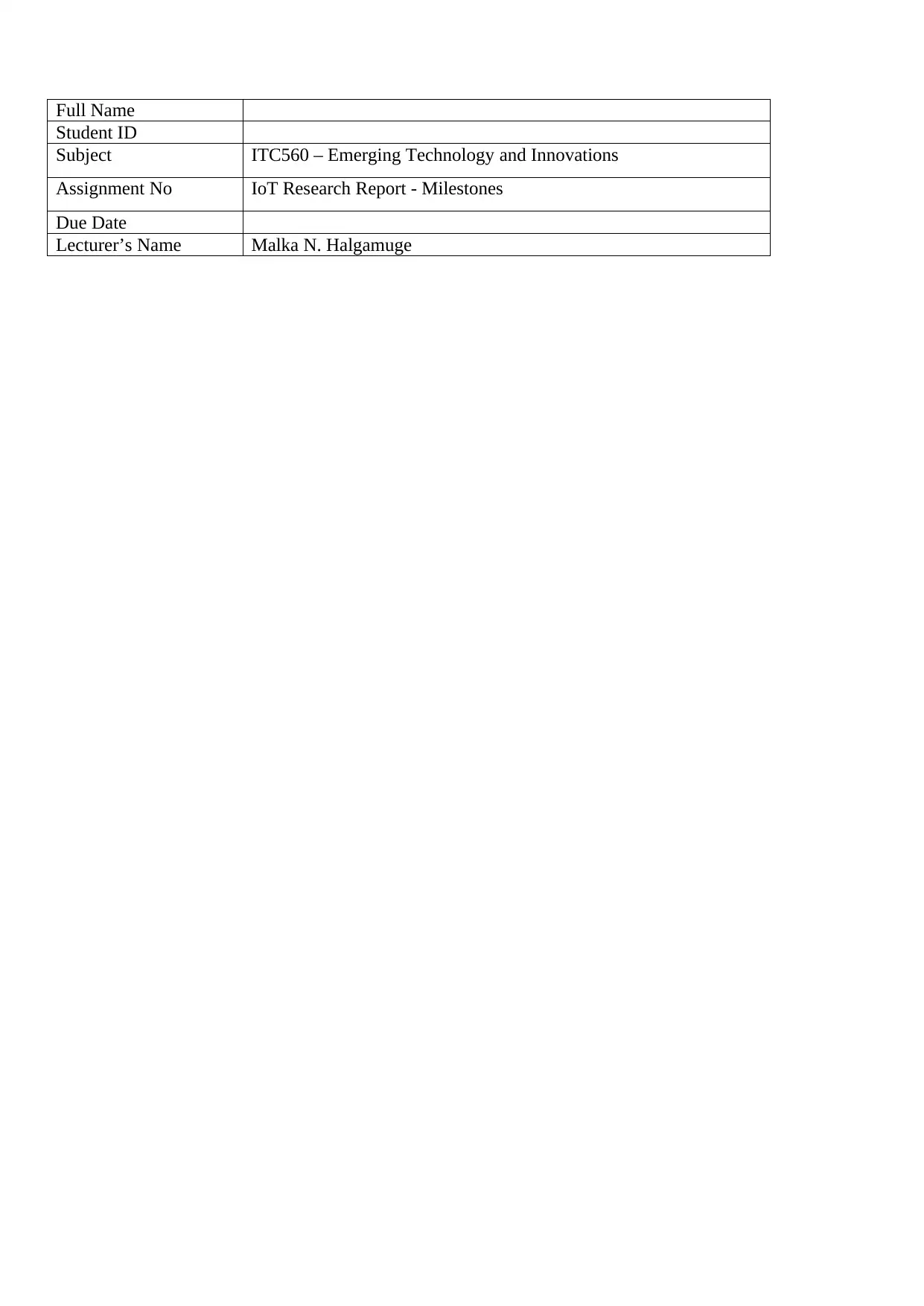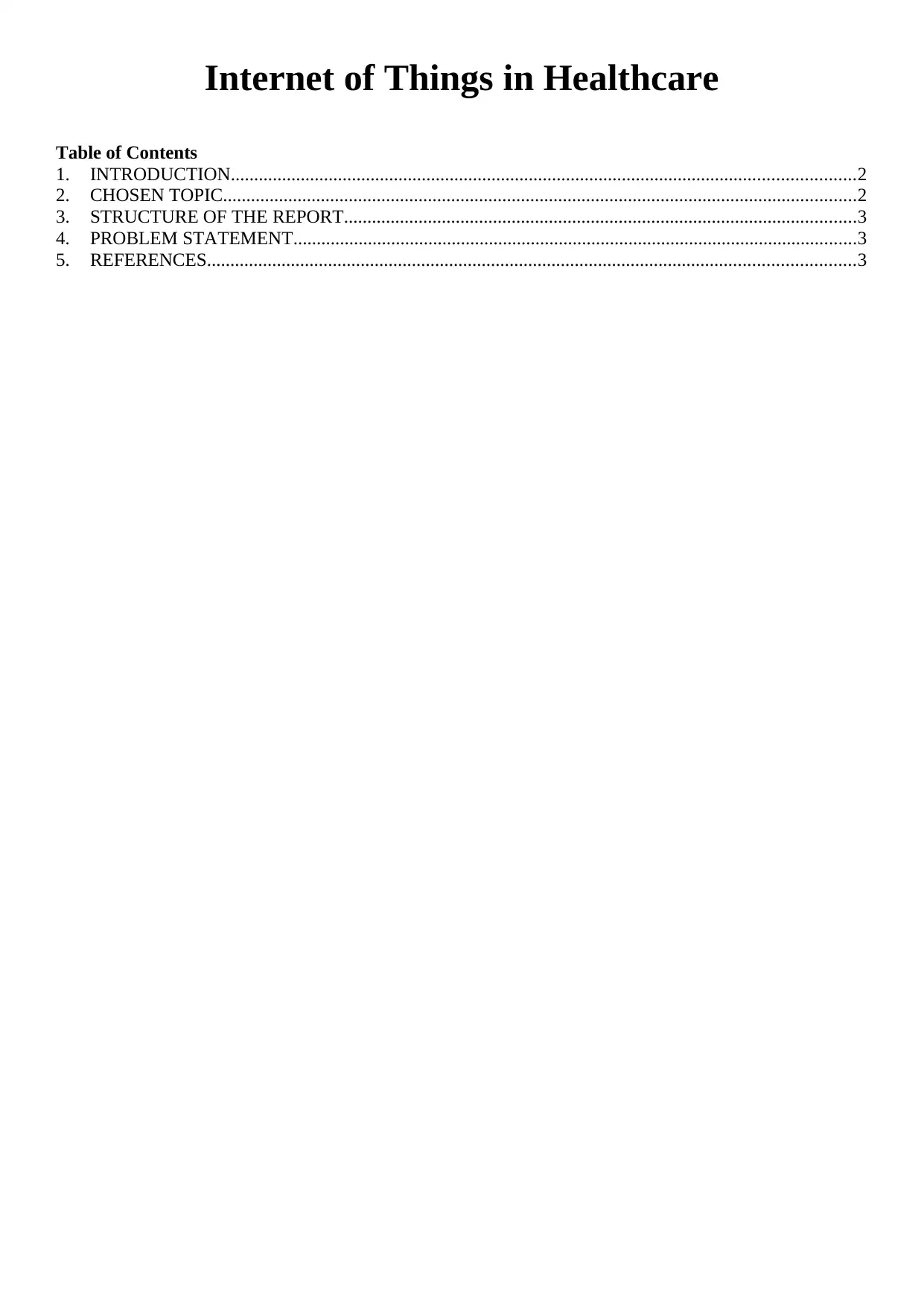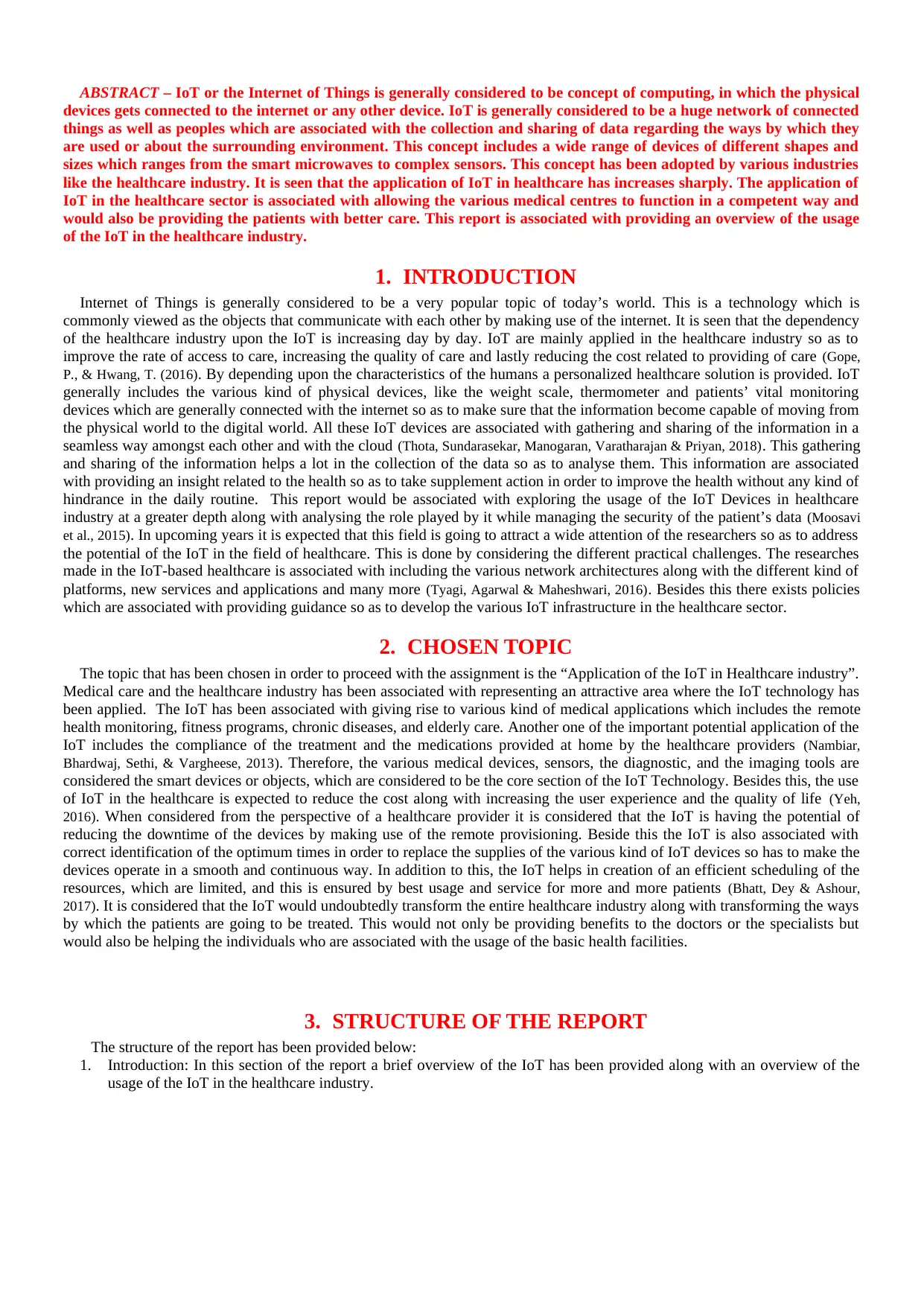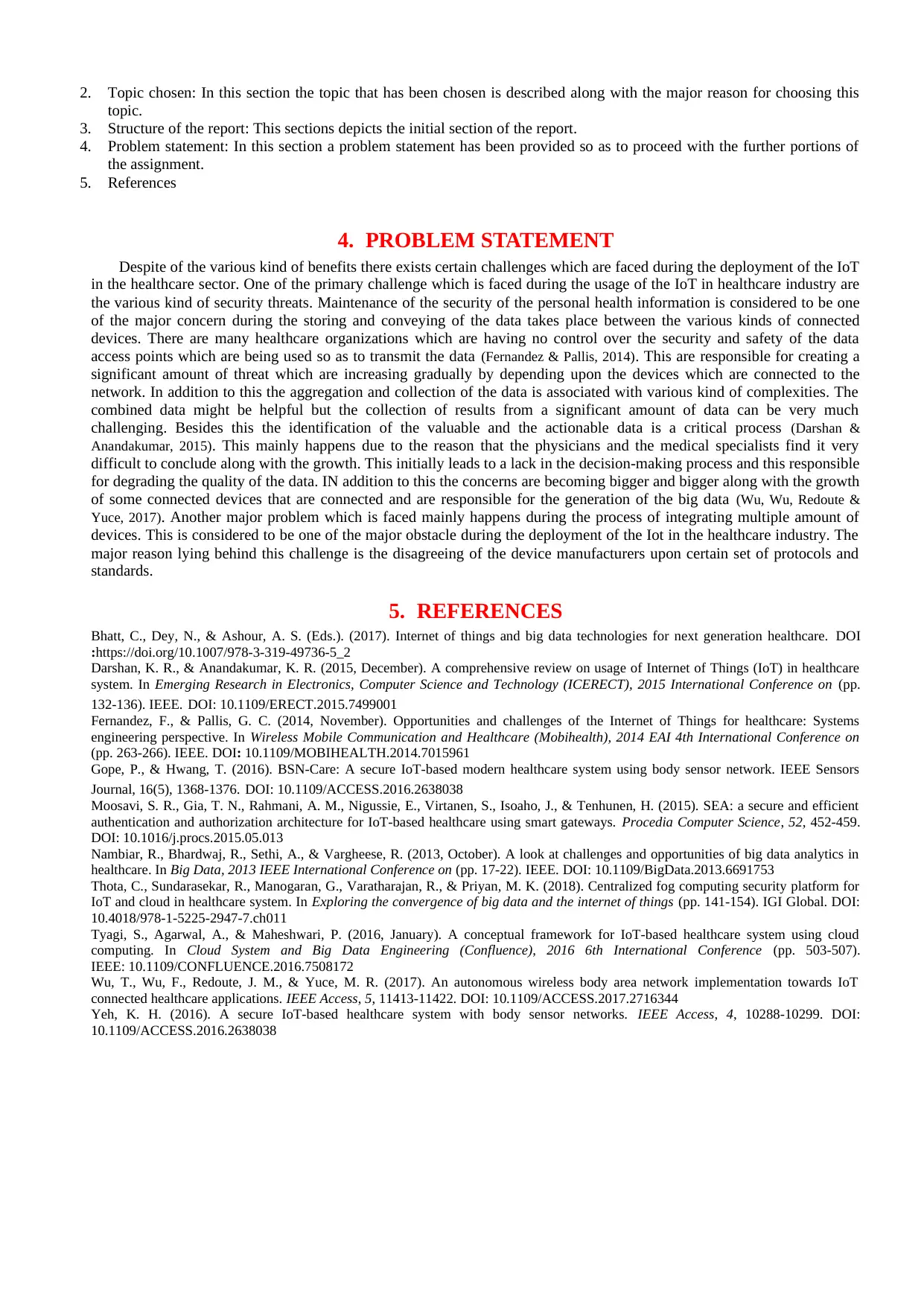ITC560 Emerging Tech: IoT's Role in Healthcare - Research Report
VerifiedAdded on 2023/06/09
|4
|2031
|273
Report
AI Summary
This report provides an overview of the Internet of Things (IoT) and its increasing application within the healthcare industry. It highlights how IoT devices, such as vital monitoring devices, facilitate data collection and sharing to improve patient care and reduce costs. The report details the applications of IoT in areas like remote health monitoring, chronic disease management, and elderly care. It also addresses the challenges associated with IoT deployment in healthcare, including security threats, data aggregation complexities, and device integration issues. The report concludes by emphasizing the transformative potential of IoT in healthcare, while also acknowledging the need to address security and integration challenges to fully realize its benefits. Desklib offers a platform to access similar solved assignments and past papers for students.

Full Name
Student ID
Subject ITC560 – Emerging Technology and Innovations
Assignment No IoT Research Report - Milestones
Due Date
Lecturer’s Name Malka N. Halgamuge
Student ID
Subject ITC560 – Emerging Technology and Innovations
Assignment No IoT Research Report - Milestones
Due Date
Lecturer’s Name Malka N. Halgamuge
Paraphrase This Document
Need a fresh take? Get an instant paraphrase of this document with our AI Paraphraser

Internet of Things in Healthcare
Table of Contents
1. INTRODUCTION......................................................................................................................................2
2. CHOSEN TOPIC........................................................................................................................................2
3. STRUCTURE OF THE REPORT..............................................................................................................3
4. PROBLEM STATEMENT.........................................................................................................................3
5. REFERENCES...........................................................................................................................................3
Table of Contents
1. INTRODUCTION......................................................................................................................................2
2. CHOSEN TOPIC........................................................................................................................................2
3. STRUCTURE OF THE REPORT..............................................................................................................3
4. PROBLEM STATEMENT.........................................................................................................................3
5. REFERENCES...........................................................................................................................................3

ABSTRACT – IoT or the Internet of Things is generally considered to be concept of computing, in which the physical
devices gets connected to the internet or any other device. IoT is generally considered to be a huge network of connected
things as well as peoples which are associated with the collection and sharing of data regarding the ways by which they
are used or about the surrounding environment. This concept includes a wide range of devices of different shapes and
sizes which ranges from the smart microwaves to complex sensors. This concept has been adopted by various industries
like the healthcare industry. It is seen that the application of IoT in healthcare has increases sharply. The application of
IoT in the healthcare sector is associated with allowing the various medical centres to function in a competent way and
would also be providing the patients with better care. This report is associated with providing an overview of the usage
of the IoT in the healthcare industry.
1. INTRODUCTION
Internet of Things is generally considered to be a very popular topic of today’s world. This is a technology which is
commonly viewed as the objects that communicate with each other by making use of the internet. It is seen that the dependency
of the healthcare industry upon the IoT is increasing day by day. IoT are mainly applied in the healthcare industry so as to
improve the rate of access to care, increasing the quality of care and lastly reducing the cost related to providing of care (Gope,
P., & Hwang, T. (2016). By depending upon the characteristics of the humans a personalized healthcare solution is provided. IoT
generally includes the various kind of physical devices, like the weight scale, thermometer and patients’ vital monitoring
devices which are generally connected with the internet so as to make sure that the information become capable of moving from
the physical world to the digital world. All these IoT devices are associated with gathering and sharing of the information in a
seamless way amongst each other and with the cloud (Thota, Sundarasekar, Manogaran, Varatharajan & Priyan, 2018). This gathering
and sharing of the information helps a lot in the collection of the data so as to analyse them. This information are associated
with providing an insight related to the health so as to take supplement action in order to improve the health without any kind of
hindrance in the daily routine. This report would be associated with exploring the usage of the IoT Devices in healthcare
industry at a greater depth along with analysing the role played by it while managing the security of the patient’s data (Moosavi
et al., 2015). In upcoming years it is expected that this field is going to attract a wide attention of the researchers so as to address
the potential of the IoT in the field of healthcare. This is done by considering the different practical challenges. The researches
made in the IoT-based healthcare is associated with including the various network architectures along with the different kind of
platforms, new services and applications and many more (Tyagi, Agarwal & Maheshwari, 2016). Besides this there exists policies
which are associated with providing guidance so as to develop the various IoT infrastructure in the healthcare sector.
2. CHOSEN TOPIC
The topic that has been chosen in order to proceed with the assignment is the “Application of the IoT in Healthcare industry”.
Medical care and the healthcare industry has been associated with representing an attractive area where the IoT technology has
been applied. The IoT has been associated with giving rise to various kind of medical applications which includes the remote
health monitoring, fitness programs, chronic diseases, and elderly care. Another one of the important potential application of the
IoT includes the compliance of the treatment and the medications provided at home by the healthcare providers (Nambiar,
Bhardwaj, Sethi, & Vargheese, 2013). Therefore, the various medical devices, sensors, the diagnostic, and the imaging tools are
considered the smart devices or objects, which are considered to be the core section of the IoT Technology. Besides this, the use
of IoT in the healthcare is expected to reduce the cost along with increasing the user experience and the quality of life (Yeh,
2016). When considered from the perspective of a healthcare provider it is considered that the IoT is having the potential of
reducing the downtime of the devices by making use of the remote provisioning. Beside this the IoT is also associated with
correct identification of the optimum times in order to replace the supplies of the various kind of IoT devices so has to make the
devices operate in a smooth and continuous way. In addition to this, the IoT helps in creation of an efficient scheduling of the
resources, which are limited, and this is ensured by best usage and service for more and more patients (Bhatt, Dey & Ashour,
2017). It is considered that the IoT would undoubtedly transform the entire healthcare industry along with transforming the ways
by which the patients are going to be treated. This would not only be providing benefits to the doctors or the specialists but
would also be helping the individuals who are associated with the usage of the basic health facilities.
3. STRUCTURE OF THE REPORT
The structure of the report has been provided below:
1. Introduction: In this section of the report a brief overview of the IoT has been provided along with an overview of the
usage of the IoT in the healthcare industry.
devices gets connected to the internet or any other device. IoT is generally considered to be a huge network of connected
things as well as peoples which are associated with the collection and sharing of data regarding the ways by which they
are used or about the surrounding environment. This concept includes a wide range of devices of different shapes and
sizes which ranges from the smart microwaves to complex sensors. This concept has been adopted by various industries
like the healthcare industry. It is seen that the application of IoT in healthcare has increases sharply. The application of
IoT in the healthcare sector is associated with allowing the various medical centres to function in a competent way and
would also be providing the patients with better care. This report is associated with providing an overview of the usage
of the IoT in the healthcare industry.
1. INTRODUCTION
Internet of Things is generally considered to be a very popular topic of today’s world. This is a technology which is
commonly viewed as the objects that communicate with each other by making use of the internet. It is seen that the dependency
of the healthcare industry upon the IoT is increasing day by day. IoT are mainly applied in the healthcare industry so as to
improve the rate of access to care, increasing the quality of care and lastly reducing the cost related to providing of care (Gope,
P., & Hwang, T. (2016). By depending upon the characteristics of the humans a personalized healthcare solution is provided. IoT
generally includes the various kind of physical devices, like the weight scale, thermometer and patients’ vital monitoring
devices which are generally connected with the internet so as to make sure that the information become capable of moving from
the physical world to the digital world. All these IoT devices are associated with gathering and sharing of the information in a
seamless way amongst each other and with the cloud (Thota, Sundarasekar, Manogaran, Varatharajan & Priyan, 2018). This gathering
and sharing of the information helps a lot in the collection of the data so as to analyse them. This information are associated
with providing an insight related to the health so as to take supplement action in order to improve the health without any kind of
hindrance in the daily routine. This report would be associated with exploring the usage of the IoT Devices in healthcare
industry at a greater depth along with analysing the role played by it while managing the security of the patient’s data (Moosavi
et al., 2015). In upcoming years it is expected that this field is going to attract a wide attention of the researchers so as to address
the potential of the IoT in the field of healthcare. This is done by considering the different practical challenges. The researches
made in the IoT-based healthcare is associated with including the various network architectures along with the different kind of
platforms, new services and applications and many more (Tyagi, Agarwal & Maheshwari, 2016). Besides this there exists policies
which are associated with providing guidance so as to develop the various IoT infrastructure in the healthcare sector.
2. CHOSEN TOPIC
The topic that has been chosen in order to proceed with the assignment is the “Application of the IoT in Healthcare industry”.
Medical care and the healthcare industry has been associated with representing an attractive area where the IoT technology has
been applied. The IoT has been associated with giving rise to various kind of medical applications which includes the remote
health monitoring, fitness programs, chronic diseases, and elderly care. Another one of the important potential application of the
IoT includes the compliance of the treatment and the medications provided at home by the healthcare providers (Nambiar,
Bhardwaj, Sethi, & Vargheese, 2013). Therefore, the various medical devices, sensors, the diagnostic, and the imaging tools are
considered the smart devices or objects, which are considered to be the core section of the IoT Technology. Besides this, the use
of IoT in the healthcare is expected to reduce the cost along with increasing the user experience and the quality of life (Yeh,
2016). When considered from the perspective of a healthcare provider it is considered that the IoT is having the potential of
reducing the downtime of the devices by making use of the remote provisioning. Beside this the IoT is also associated with
correct identification of the optimum times in order to replace the supplies of the various kind of IoT devices so has to make the
devices operate in a smooth and continuous way. In addition to this, the IoT helps in creation of an efficient scheduling of the
resources, which are limited, and this is ensured by best usage and service for more and more patients (Bhatt, Dey & Ashour,
2017). It is considered that the IoT would undoubtedly transform the entire healthcare industry along with transforming the ways
by which the patients are going to be treated. This would not only be providing benefits to the doctors or the specialists but
would also be helping the individuals who are associated with the usage of the basic health facilities.
3. STRUCTURE OF THE REPORT
The structure of the report has been provided below:
1. Introduction: In this section of the report a brief overview of the IoT has been provided along with an overview of the
usage of the IoT in the healthcare industry.
⊘ This is a preview!⊘
Do you want full access?
Subscribe today to unlock all pages.

Trusted by 1+ million students worldwide

2. Topic chosen: In this section the topic that has been chosen is described along with the major reason for choosing this
topic.
3. Structure of the report: This sections depicts the initial section of the report.
4. Problem statement: In this section a problem statement has been provided so as to proceed with the further portions of
the assignment.
5. References
4. PROBLEM STATEMENT
Despite of the various kind of benefits there exists certain challenges which are faced during the deployment of the IoT
in the healthcare sector. One of the primary challenge which is faced during the usage of the IoT in healthcare industry are
the various kind of security threats. Maintenance of the security of the personal health information is considered to be one
of the major concern during the storing and conveying of the data takes place between the various kinds of connected
devices. There are many healthcare organizations which are having no control over the security and safety of the data
access points which are being used so as to transmit the data (Fernandez & Pallis, 2014). This are responsible for creating a
significant amount of threat which are increasing gradually by depending upon the devices which are connected to the
network. In addition to this the aggregation and collection of the data is associated with various kind of complexities. The
combined data might be helpful but the collection of results from a significant amount of data can be very much
challenging. Besides this the identification of the valuable and the actionable data is a critical process (Darshan &
Anandakumar, 2015). This mainly happens due to the reason that the physicians and the medical specialists find it very
difficult to conclude along with the growth. This initially leads to a lack in the decision-making process and this responsible
for degrading the quality of the data. IN addition to this the concerns are becoming bigger and bigger along with the growth
of some connected devices that are connected and are responsible for the generation of the big data (Wu, Wu, Redoute &
Yuce, 2017). Another major problem which is faced mainly happens during the process of integrating multiple amount of
devices. This is considered to be one of the major obstacle during the deployment of the Iot in the healthcare industry. The
major reason lying behind this challenge is the disagreeing of the device manufacturers upon certain set of protocols and
standards.
5. REFERENCES
Bhatt, C., Dey, N., & Ashour, A. S. (Eds.). (2017). Internet of things and big data technologies for next generation healthcare. DOI
:https://doi.org/10.1007/978-3-319-49736-5_2
Darshan, K. R., & Anandakumar, K. R. (2015, December). A comprehensive review on usage of Internet of Things (IoT) in healthcare
system. In Emerging Research in Electronics, Computer Science and Technology (ICERECT), 2015 International Conference on (pp.
132-136). IEEE. DOI: 10.1109/ERECT.2015.7499001
Fernandez, F., & Pallis, G. C. (2014, November). Opportunities and challenges of the Internet of Things for healthcare: Systems
engineering perspective. In Wireless Mobile Communication and Healthcare (Mobihealth), 2014 EAI 4th International Conference on
(pp. 263-266). IEEE. DOI: 10.1109/MOBIHEALTH.2014.7015961
Gope, P., & Hwang, T. (2016). BSN-Care: A secure IoT-based modern healthcare system using body sensor network. IEEE Sensors
Journal, 16(5), 1368-1376. DOI: 10.1109/ACCESS.2016.2638038
Moosavi, S. R., Gia, T. N., Rahmani, A. M., Nigussie, E., Virtanen, S., Isoaho, J., & Tenhunen, H. (2015). SEA: a secure and efficient
authentication and authorization architecture for IoT-based healthcare using smart gateways. Procedia Computer Science, 52, 452-459.
DOI: 10.1016/j.procs.2015.05.013
Nambiar, R., Bhardwaj, R., Sethi, A., & Vargheese, R. (2013, October). A look at challenges and opportunities of big data analytics in
healthcare. In Big Data, 2013 IEEE International Conference on (pp. 17-22). IEEE. DOI: 10.1109/BigData.2013.6691753
Thota, C., Sundarasekar, R., Manogaran, G., Varatharajan, R., & Priyan, M. K. (2018). Centralized fog computing security platform for
IoT and cloud in healthcare system. In Exploring the convergence of big data and the internet of things (pp. 141-154). IGI Global. DOI:
10.4018/978-1-5225-2947-7.ch011
Tyagi, S., Agarwal, A., & Maheshwari, P. (2016, January). A conceptual framework for IoT-based healthcare system using cloud
computing. In Cloud System and Big Data Engineering (Confluence), 2016 6th International Conference (pp. 503-507).
IEEE: 10.1109/CONFLUENCE.2016.7508172
Wu, T., Wu, F., Redoute, J. M., & Yuce, M. R. (2017). An autonomous wireless body area network implementation towards IoT
connected healthcare applications. IEEE Access, 5, 11413-11422. DOI: 10.1109/ACCESS.2017.2716344
Yeh, K. H. (2016). A secure IoT-based healthcare system with body sensor networks. IEEE Access, 4, 10288-10299. DOI:
10.1109/ACCESS.2016.2638038
topic.
3. Structure of the report: This sections depicts the initial section of the report.
4. Problem statement: In this section a problem statement has been provided so as to proceed with the further portions of
the assignment.
5. References
4. PROBLEM STATEMENT
Despite of the various kind of benefits there exists certain challenges which are faced during the deployment of the IoT
in the healthcare sector. One of the primary challenge which is faced during the usage of the IoT in healthcare industry are
the various kind of security threats. Maintenance of the security of the personal health information is considered to be one
of the major concern during the storing and conveying of the data takes place between the various kinds of connected
devices. There are many healthcare organizations which are having no control over the security and safety of the data
access points which are being used so as to transmit the data (Fernandez & Pallis, 2014). This are responsible for creating a
significant amount of threat which are increasing gradually by depending upon the devices which are connected to the
network. In addition to this the aggregation and collection of the data is associated with various kind of complexities. The
combined data might be helpful but the collection of results from a significant amount of data can be very much
challenging. Besides this the identification of the valuable and the actionable data is a critical process (Darshan &
Anandakumar, 2015). This mainly happens due to the reason that the physicians and the medical specialists find it very
difficult to conclude along with the growth. This initially leads to a lack in the decision-making process and this responsible
for degrading the quality of the data. IN addition to this the concerns are becoming bigger and bigger along with the growth
of some connected devices that are connected and are responsible for the generation of the big data (Wu, Wu, Redoute &
Yuce, 2017). Another major problem which is faced mainly happens during the process of integrating multiple amount of
devices. This is considered to be one of the major obstacle during the deployment of the Iot in the healthcare industry. The
major reason lying behind this challenge is the disagreeing of the device manufacturers upon certain set of protocols and
standards.
5. REFERENCES
Bhatt, C., Dey, N., & Ashour, A. S. (Eds.). (2017). Internet of things and big data technologies for next generation healthcare. DOI
:https://doi.org/10.1007/978-3-319-49736-5_2
Darshan, K. R., & Anandakumar, K. R. (2015, December). A comprehensive review on usage of Internet of Things (IoT) in healthcare
system. In Emerging Research in Electronics, Computer Science and Technology (ICERECT), 2015 International Conference on (pp.
132-136). IEEE. DOI: 10.1109/ERECT.2015.7499001
Fernandez, F., & Pallis, G. C. (2014, November). Opportunities and challenges of the Internet of Things for healthcare: Systems
engineering perspective. In Wireless Mobile Communication and Healthcare (Mobihealth), 2014 EAI 4th International Conference on
(pp. 263-266). IEEE. DOI: 10.1109/MOBIHEALTH.2014.7015961
Gope, P., & Hwang, T. (2016). BSN-Care: A secure IoT-based modern healthcare system using body sensor network. IEEE Sensors
Journal, 16(5), 1368-1376. DOI: 10.1109/ACCESS.2016.2638038
Moosavi, S. R., Gia, T. N., Rahmani, A. M., Nigussie, E., Virtanen, S., Isoaho, J., & Tenhunen, H. (2015). SEA: a secure and efficient
authentication and authorization architecture for IoT-based healthcare using smart gateways. Procedia Computer Science, 52, 452-459.
DOI: 10.1016/j.procs.2015.05.013
Nambiar, R., Bhardwaj, R., Sethi, A., & Vargheese, R. (2013, October). A look at challenges and opportunities of big data analytics in
healthcare. In Big Data, 2013 IEEE International Conference on (pp. 17-22). IEEE. DOI: 10.1109/BigData.2013.6691753
Thota, C., Sundarasekar, R., Manogaran, G., Varatharajan, R., & Priyan, M. K. (2018). Centralized fog computing security platform for
IoT and cloud in healthcare system. In Exploring the convergence of big data and the internet of things (pp. 141-154). IGI Global. DOI:
10.4018/978-1-5225-2947-7.ch011
Tyagi, S., Agarwal, A., & Maheshwari, P. (2016, January). A conceptual framework for IoT-based healthcare system using cloud
computing. In Cloud System and Big Data Engineering (Confluence), 2016 6th International Conference (pp. 503-507).
IEEE: 10.1109/CONFLUENCE.2016.7508172
Wu, T., Wu, F., Redoute, J. M., & Yuce, M. R. (2017). An autonomous wireless body area network implementation towards IoT
connected healthcare applications. IEEE Access, 5, 11413-11422. DOI: 10.1109/ACCESS.2017.2716344
Yeh, K. H. (2016). A secure IoT-based healthcare system with body sensor networks. IEEE Access, 4, 10288-10299. DOI:
10.1109/ACCESS.2016.2638038
1 out of 4
Related Documents
Your All-in-One AI-Powered Toolkit for Academic Success.
+13062052269
info@desklib.com
Available 24*7 on WhatsApp / Email
![[object Object]](/_next/static/media/star-bottom.7253800d.svg)
Unlock your academic potential
Copyright © 2020–2025 A2Z Services. All Rights Reserved. Developed and managed by ZUCOL.



